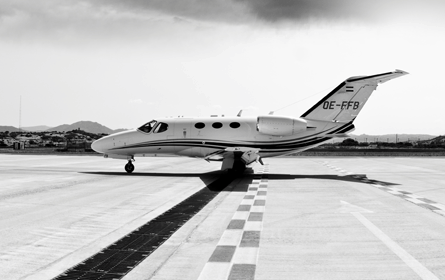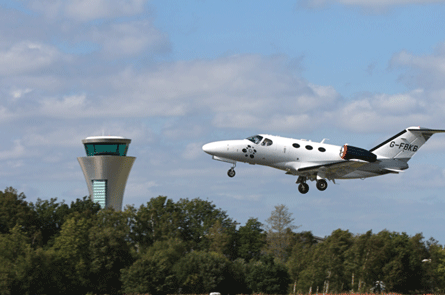This was the elevator pitch. Thousands of time-pressed executives want a more efficient way of getting between appointments in Europe. A breakthrough mass-produced technology - the very light jet - makes it possible to offer them fast, on-demand private air travel at prices rivalling airline business class. But rather than trudge through crowded, security-clogged airports, they turn up at their local airfield and fly wherever they want in a 90min radius.
It is easy to see why during the economic boom so many entrepreneurs and investors - in Europe and the USA - became quickly convinced of the money-making potential of the air taxi. The reasons for the concept's failed take-off in 2009 are well-known: an economic crash that saw customers and investors vanish and the demise of the VLJ manufacturer, Eclipse Aviation, that foretold the air taxi revolution with its Eclipse 500.
But with European economies recuperating, does the air taxi model have a future? It seems unlikely, but there are survivors among the visionaries of three years ago convinced the market will return. They have been kept in business largely by broker-supplied traditional private aviation customers, downsizing from larger jets - sportsmen, rock stars and self-made multi-millionaires.
 |
|---|
© GlobeAirThe most successful air taxi pioneer, Austri's GloeAir, switched its business model before getting too big. It has a fleet of 11 Mustangs |
By late 2008, the number of air taxi start-ups across Europe had reached double figures. Their combined commitments for the likes of the Cessna Mustang, Eclipse 500 and Embraer Phenom 100 were in the hundreds. Most, like Dutch firm Bikkair, which had planned a fleet of 100 Mustangs, went the way of the biggest air taxi casualty of all, Florida's DayJet: their death notices often in the form of a short, hurried, apologetic press release.
Others, such as Blink, which had 30 Mustangs on order, quietly reinvented themselves as traditional charter carriers, offering a lower-cost alternative to the high rollers who use private jets to flit between business meetings, ski resorts and Mediterranean villas. After launching revenue flights in May 2008, the UK carrier - now based modestly among the flying schools at Blackbushe airfield near Farnborough - has eight Mustangs, seven leased from a sister company.
BLINK CHANGE
Blink's co-founder Cameron Ogden says the past three years have been a "belter" - not in a good sense - forcing the company to "flip on its head" its plan to sell pre-paid packages directly to investment banks and other corporate clients. "Our business model was based on convincing premium class passengers to switch, and to give them an alternative to NetJets. We were close to finalising contracts when the crash came," he says. "We had to become a private jet-down model, with a totally different demographic and sales strategy, selling a more subtly branded and more wholesale product through brokers."
 |
|---|
© BlinkBlink has now reinvented itself as a charter carrier |
The former Goldman Sachs broker says Blink has finance to continue operating at its current scale - this year the company hopes to fly 650h per jet, up from "high 500s" in 2010 - but admits: "We are not content being this size on a long-term basis." Eventually, he believes, the corporate customer will return and realise the huge time- and cost-saving advantages of the VLJ.
SUCCESSFUL PIONEER
The most successful air taxi pioneer has been Austria's GlobeAir, which has just expanded its fleet to 11 Mustangs. Founder Bernhard Fragner describes himself as one of the "crazy idiots" who became convinced of the paradigm-shifting potential of the Eclipse 500 in the early 2000s. Instead, however, the company launched in early 2008 with four Mustangs, quickly realising that its was "the worst time to set up".
Like Blink, Fragner says the timing of the slump meant GlobeAir could switch its business model before getting too big. "Initially we intended to take business travellers from the airlines, but we ended up taking business jet users who were stepping down," he says. "We had to learn to be really lean and look at every cost."
Although based in Linz, GlobeAir has focused on the demographic "golden banana" that stretches from London through Paris and Amsterdam down to Geneva and Milan and has 80% of Europe's VIPs. With 11 aircraft, Fragner believes he has critical mass to use his assets efficiently, often dropping a passenger in one city in the morning and using another aircraft to pick him up that evening.
Pricing is based on a "probability matrix": the more popular a route, the cheaper the rate. Two employees work on "business intelligence", predicting where GlobeAir should position aircraft, which are averaging almost 1,000h a year. Like Blink, GlobeAir uses brokers, but is developing its own sales operation, from which it gets 40% of its revenue. "In the beginning we were 100% broker," says Fragner. "But how to develop is through a partner network. We are on the way there."
Other VLJ operators either abandoned air taxi projects earlier or never considered them. London Executive Aviation - one of the UK's leading charter operators with a fleet of 24 aircraft - tried and failed to raise money for an air taxi venture in the mid-2000s. It has shed four of the eight Mustangs it intended to use for the operation.
Managing director George Galanopoulos has no regrets. "To run a point to point operation efficiently, you have to utilise aircraft for 1,000-1,200h, which is almost impossible in a private aircraft," he says. "Much of the demand is one-way. But the problem is that you then have to sell the next sector to minimise dead legs. The volume just isn't there."
David Fletcher, chief executive of Oxford-based FlairJet - in 2010 the first European operator to put the Phenom 100 and its big sister, the Phenom 300, into service - says an air taxi venture was "never our aim - we saw ourselves as private jet charter". Air taxi models were "in with a shout if well funded and launched before the peak, but the concept involves huge sums and a huge risk", he says. "We knew from day one our main customer was the broker and it was not about selling direct or promoting our brand."
 |
|---|
© DayJetFlorida's DayJet was the biggst air taxi casualty |
Joe Leader, who runs the US-based Air Taxi and Air Charter Association, admits the European market has "fallen far short" of the "inflated expectations prior to 2008". However, he believes the sector has "crossed the worst and is seeing utilisation tipping up and up".
The biggest problem, he says, is that there are no online sites like Expedia where users can compare prices as they can with commercial carriers. "If you have four or five people travelling from A to B, they don't know what the alternatives are to the airlines," he says. "Back in 2007, the idea was that if you put a pile of jets into the market, the demand would just come. But you have to look at the context of how people actually book travel."
Edwin Brenninkmeyer, chief executive of VLJ consultancy Oriens Advisors, says the "potential of the [air taxi] market" has not changed since 2007. The key is getting the price competitive with airlines, and this can only be done by achieving scale, he says.
Getting the ownership model right is crucial. "Companies that have been successful have gone down the managed aircraft route. If you can identify a few corporate customers and attach value to them, then you can pitch for funding to scale the business," he says.
Brenninkmeyer believes in a world in which air taxis co-exist with the airlines. If an executive wants to go from London to Frankfurt, he goes scheduled, he says. "If he wants to fly from Sienna to Basle, or visit factories and customers in out-of-the-way places over a few days, then VLJs make perfect sense."
- That was the hype that was. Read Murdo Morrison's 2006 article on the original air taxi vision in the USA
Source: Flight International
















